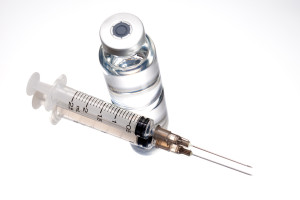When Rules Matter Most: Managing Your Horse’s Medication
Merial
You may have watched as a horse was singled out after their class by a drug tester who followed them back to the barn area to collect a blood or urine sample. Maybe you’ve even experienced it yourself. This testing is for a good reason — it ensures compliance of the rules which are driven by a mission to protect equine welfare.1
The majority of associations use the United States Equestrian Federation (USEF) Equine Drugs and Medication Rules as a general guideline, which outlines specifics in regard to both allowed and prohibited medications, drugs and other substances.
Clearly, in the world of equestrian competition, prohibited substances should be avoided. But sometimes there is confusion about allowed therapies, like non-steroidal anti-inflammatory drugs (NSAIDs).
Abiding by the Rules: Shows vs. Barns
Timing and dosage can vary greatly between what’s allowed for a particular show and common barn and at home practices for medication administration. Before giving your horse any medication, check the rule book for the association at which you are planning to show.
For example, NSAIDs, used to treat conditions such as the pain and inflammation associated with equine osteoarthritis,2 usually have restricted doses based on allowed blood levels at the time of competition as well as withdrawal time recommendations.
“Managing joint health is often an ongoing process — and it doesn’t stop just because you have a show or competition,” says Hoyt Cheramie, DVM, MS, DACVS, Senior Manager, Merial Large Animal Veterinary Services. “Veterinarians may suggest an NSAID, but it’s important to give the correct dose, especially when showing.”
Weight Watching: Where Tablets Fit in Your Horse’s Regimen
With the recent announcement of a tablet formulation, Merial, the makers of EQUIOXX® (firocoxib), wants to ensure that horse owners, exhibitors, trainers and veterinarians are giving EQUIOXX in compliance with each association’s rules.
“While EQUIOXX Tablets are a great option for routine use in non-competition settings, equestrians need to be aware that they are labeled for 800 to 1,300 pounds. This may mean they aren’t the best option for some competition horses,” Cheramie says. “The approved dose and withdrawal time of oral firocoxib to ensure accepted blood level requirements for showing is 0.1 mg/kg given a minimum 12 hours before showing. Thus, for the purposes of competition drug testing, any horse weighing less than 1,254 pounds receiving the 57 mg tablet is receiving a higher dosage than competition rules allow. Depending on the weight of your horse, this could make it difficult to stay within the allowable limits. For instance, a 1,000 pound horse would get 25 percent more firocoxib by weight than permissible by the competition rules when given a full 57 mg EQUIOXX tablet. This would put the horse at risk for testing above the allowed blood level for firocoxib.”
Equestrians must sometimes estimate the weight of a horse when administering treatment, but even those with years of experience routinely misjudge horses’ body weight.3 When giving any NSAID, an accurate body-weight assessment — preferably with a scale or, at the very least, a weight tape — is necessary for proper dosage.3 Over dosing can cause overages of allowed levels, while under dosing can result in a less than effective result.
“When showing, the paste or injection formulations of EQUIOXX offer the most accurate dosing to help riders and trainers stay in compliance with their association’s medication rules,” Cheramie says. “Paste can be dosed to 50-pound increments, and the injection can be dosed to the exact weight of the horse making it the most precise.”
Here are a few reminders when treating your horse with an NSAID prior to competition, according to the USEF.1 Please note these reminders are in accordance with USEF rules, and although most associations use USEF rules as a general guideline, please refer to your association’s rules for specifics.
- NSAIDs are to be administered to a horse or pony only for a therapeutic purpose.
- There are specific administration guidelines for each NSAID that must be followed, which can be found on the USEF website.
- In most organizations, only one NSAID (of those permitted to be used) may be used at a time.
- Whenever a permitted NSAID is administered, any additional permitted NSAID should not have been administered at least three days prior to competing, depending on the NSAID.
- If you have a need to switch your horse from one to another, work with your veterinarian to ensure you leave the appropriate “wash out” time, which may be longer than three days, depending on their individual duration of effect.
- NSAIDs that don’t appear on the permitted list must not be administered during the seven days prior to competing.
- The dose should be accurately calculated according to the actual weight of the animal.
- Based on the drug and dose, USEF may have recommendations for latest administration hour prior to competition. For EQUIOXX, that withdrawal time is greater than 12 hours.
- Many competitors choose EQUIOXX because it is the only equine coxib NSAID and can be used for up to 14 days.4 This 14-day duration is longer than all other NSAIDs.1
Show smart
Don’t risk over or under dosing during training or before a competition. Talk to your veterinarian about the best administration options for your horse and consult your individual association’s rules regarding medications.
IMPORTANT SAFETY INFORMATION
As with any prescription medication, prior to use, a veterinarian should perform a physical examination and review the horse’s medical history. A veterinarian should advise horse owners to observe for signs of potential drug toxicity. As a class, nonsteroidal anti‐inflammatory drugs may be associated with gastrointestinal, hepatic and renal toxicity. Use with other NSAIDs, corticosteroids or nephrotoxic medication should be avoided. EQUIOXX has not been tested in horses less than 1 year of age or in breeding horses, or pregnant or lactating mares. For additional information, please refer to the prescribing information or visit www.equioxx.com.











